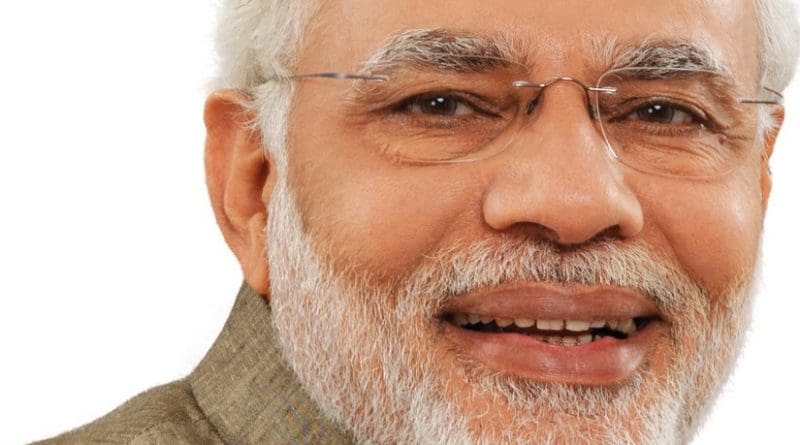Reshaping India’s Blue Economy Imperative – Analysis
By Luciane Noronha M. de Oliveira*
It has been almost two years since India’s former Defence Minister, Manohar Parrikar, unveiled the new version of India’s Maritime Military Strategy. The document reflects the changes in New Delhi’s international agenda and its so-called ‘Blue economy’. Regarding its highly sea-dependent economy, shaping a favorable maritime environment has been a priority for the current administration of Narendra Modi.
First of all, it is important to conceptualize what does ‘Blue Economy’ mean. As the name suggests, it is directly linked to maritime commercial activities, which is not a recent phenomenon in human history. However, this expression gained a new momentum in the last few years with its usage in the Rio+20 United Nations Conference on Sustainable Development, in 2012. The ‘Blue Economy’ concept stands for the prudent exploration of sea resources in a sustainable manner, supporting the “Green economy” notion which supports a similar idea applied for in-land environment.
As for India, the “Blue Economy” has been reshaped to something more than just the ecological aspect of it to be a geopolitical imperative. Roughly 90% of its overall trade is made by the sea. The country imports around 80% of its oil through sea lines of communication. By 2020, it is estimated to reach up to 90%. Lastly, the Indian Ocean Region (IOR) has seen an increase of extrar-regional countries’ presence, which accounts as a possible threat to India’s national interests and the control of sea it seeks for, according to the Maritime Doctrine.
For instance, through its China-Pakistan Economic Corridor (CPEC), as part of its String of Pearls strategy, China started building a steady footprint in New Delhi’s most important area of interest. Piracy off the Somali coast was in decrease, but seems to be gaining strength once again, as shown by new reports by the U.S Navy. All of this is relevant to understand what is the stage of the current Maritime Strategy of India.
Maintaining the geopolitical scope of the text, what are the main features of India’s 2015 Maritime Strategy? What has India gained for its national interests, two years from its publication?
In the recent years, economic diplomacy has received a lot of attention from New Delhi. It can be seen by the frequent visits made by India’s Prime Minister to other countries and by the Make in India initiative. The new commitments of foreign policy led to a greater dimension of the Indian Ocean as a highly important region for India’s development and the need for securing the critic sea lines of communication.
Regarding this context, one can point out three main features of the 2015 Maritime Strategy of India: the quest for port-building in foreign friendly countries to enhance its presence in strategically important regions, the new contours of areas of interest and the outreach of the Act East and Link West policies. A first move was made towards Iran, India’s third main oil supplier, with the Chabahar Port project and the signing of a Memorandum between India, Iran and Afghanistan (2016) which gives New Delhi a strategic access to the Gulf and Central Asia. The project is still in progress and can be interpreted as an experiment of huge infrastructure building of India in a foreign country. Building and operations ports outside India can help enhancing its presence throughout the world. The Indian Navy states that it means being able to operate further away from the coast and give the country a forward presence, therefore stimulating capacity building and a stronger Navy.
Second, the new areas of primary and secondary interest were enlarged, and now India’s interest area reaches South Atlantic, as a reflection of the stronger ties built with African countries in the Western coast. Nigeria is now the main oil supplier of India in Africa and fifth in the overall rank released this year. It is no coincidence that at every visit made by Prime Minister Narendra Modi, his speech carries out something about maritime cooperation and information sharing between Africa and India.
As for the Navy, the 2015 Maritime Strategy points out ventures like the Indian Ocean Naval Symposium (IONS), among other meetings as a focus of India’s current interests. The same can be said about Southeast Asia and the growing convergence between India and Japan, which are incressingly keen on cooperating on maritime issues in the IOR and the Pacific.
Third, the new Maritime Strategy has expanded the reach for its Act East and Link West policies as a consequence of the expansion of India’s Foreign Policy reach, as aforementioned.
Two years might be a short timeframe to evaluate what has been gained from a strategy, but we can notice a few shifts of India’s footprint in the world since 2015, keeping in mind that Navies are, by definition, an extent of a state’s foreign policy.
Concerning India’s aspiration to play an increasingly global role and become a great Power, and its dependency on maritime trade, the ‘Blue Economy’ imperative has evolved to be one of the main focuses of its Foreign Policy. The geopolitical dimension of the term meant strengthening ties with Africa, Southeast Asian countries and Europe in a bolder way than what was seen in the previous Maritime Strategy of 2007.
Last but not least, India’s 2015 Maritime Strategy paints a clearer picture of New Delhi’s global aspirations and national interests than the previous version of 2007. The most recent example of these shifts is the Asia-Africa Growth Corridor (AAGC), a partnership between India and Japan. Pushing the Chinese factor to the side and the interpretations that focus on the balancing of the Belt and Road initiative, this is a clear example of what New Delhi’s new strategy comprises: a global outreach alongside strategic partners, shaping a more favorable environment for its Blue Economy interests.
*Luciane Noronha M. de Oliveira, Master of Arts in Maritime Studies and Fellow of South Asian Affairs of the Brazilian Naval War College.

